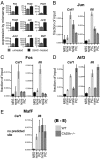25-Hydroxycholesterol acts as an amplifier of inflammatory signaling
- PMID: 24994901
- PMCID: PMC4115544
- DOI: 10.1073/pnas.1404271111
25-Hydroxycholesterol acts as an amplifier of inflammatory signaling
Abstract
Cross-talk between sterol regulatory pathways and inflammatory pathways has been demonstrated to significantly impact the development of both atherosclerosis and infectious disease. The oxysterol 25-hydroxycholesterol (25HC) plays multiple roles in lipid biosynthesis and immunity. We recently used a systems biology approach to identify 25HC as an innate immune mediator that had a predicted role in atherosclerosis and we demonstrated a role for 25HC in foam cell formation. Here, we show that this mediator also has several complex roles in the antiviral response. The host response to viruses involves gene regulatory circuits with multiple feedback loops and we show here that 25HC acts as an amplifier of inflammatory signaling in macrophages. We determined that 25HC amplifies inflammatory signaling, at least in part, by mediating the recruitment of the AP-1 components FBJ osteosarcoma oncogene (FOS) and jun proto-oncogene (JUN) to the promoters of a subset of Toll-like receptor-responsive genes. Consistent with previous reports, we found that 25HC inhibits in vitro infection of airway epithelial cells by influenza. Surprisingly, we found that deletion of Ch25h, the gene encoding the enzyme responsible for 25HC production, is protective in a mouse model of influenza infection as a result of decreased inflammatory-induced pathology. Thus, our study demonstrates, for the first time to our knowledge, that in addition to its direct antiviral role, 25HC also regulates transcriptional responses and acts as an amplifier of inflammation via AP-1 and that the resulting alteration in inflammatory response leads to increased tissue damage in mice following infection with influenza.
Conflict of interest statement
The authors declare no conflict of interest.
Figures




References
-
- Chawla A, et al. PPAR-gamma dependent and independent effects on macrophage-gene expression in lipid metabolism and inflammation. Nat Med. 2001;7(1):48–52. - PubMed
-
- Castrillo A, et al. Crosstalk between LXR and toll-like receptor signaling mediates bacterial and viral antagonism of cholesterol metabolism. Mol Cell. 2003;12(4):805–816. - PubMed
-
- Joseph SB, Castrillo A, Laffitte BA, Mangelsdorf DJ, Tontonoz P. Reciprocal regulation of inflammation and lipid metabolism by liver X receptors. Nat Med. 2003;9(2):213–219. - PubMed
-
- Jiang C, Ting AT, Seed B. PPAR-gamma agonists inhibit production of monocyte inflammatory cytokines. Nature. 1998;391(6662):82–86. - PubMed
Publication types
MeSH terms
Substances
Associated data
- Actions
- Actions
Grants and funding
LinkOut - more resources
Full Text Sources
Other Literature Sources
Molecular Biology Databases
Miscellaneous

